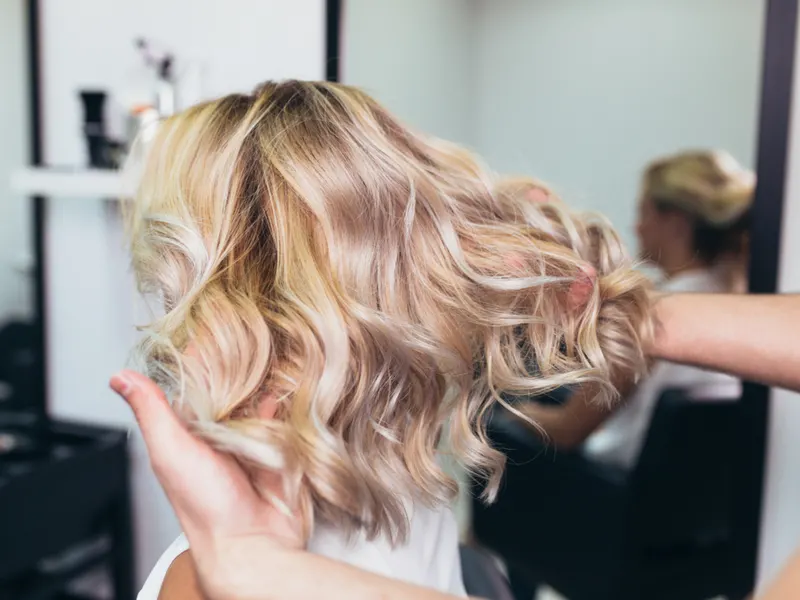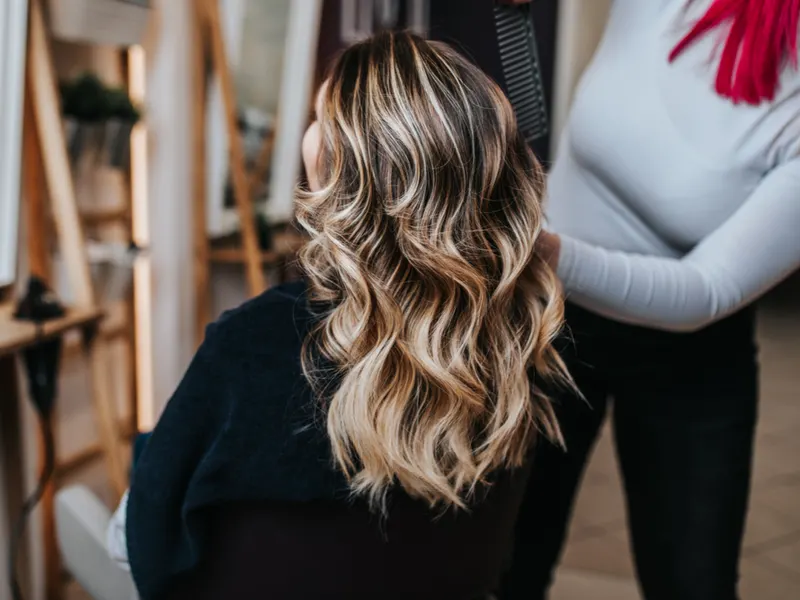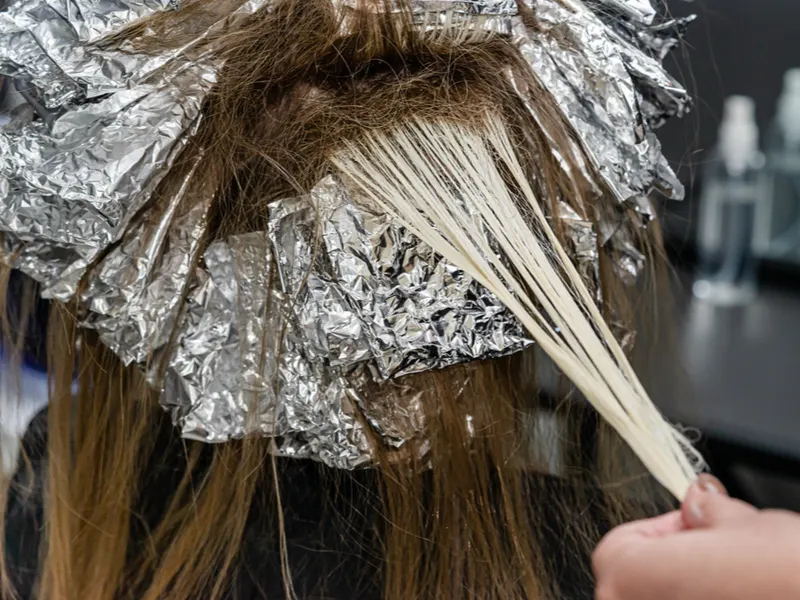Jump to:
The next time you head to the salon to refresh and rejuvenate your locks, you might be tempted to stay away from bleaching, harsh treatments, and chemicals. But does balayage damage hair, and is it just as damaging as bright-white bleach on your scalp?
Does Balayage Damage Your Hair?
Balayage is a less-damaging hair color technique that highlights “random” sections of hair to provide a more natural and sun-kissed look.
Instead of bleach streaks or all-over highlights, balayage uses a sweeping motion to add color to the midshaft and ends of your hair. But does it damage your hair?
Yes, balayage does damage your hair. But this process uses artificial color to include streaks into your toned locks, so it’s not as damaging as harsh chemicals and bleach.
Since balayage highlights don’t completely saturate your hair but simply use pieces of hair, the process makes your hair healthier, softer, and shinier. Balayage highlights don’t start at your roots or touch your scalp during use, but from the middle down to the ends through strands.
When your hair grows out, there is no harsh line of where the chemicals started, and your natural hair begins. Instead, after 8-12 weeks, the result is much more natural, making this a more low-maintenance option than bleaching and highlighting.
Conversely to bleach, balayage is applied to the strands of your hair. Therefore, there is no saturation of harsh chemicals into your scalp and roots but just surface-coloring to your mid shafts.
You Might Also Like:
- Can You Go From Highlights to Balayage?
- Balayage vs. Highlights
- Can You Dye Your Hair After Bleaching?
- How to Tell If Your Hair Is Damaged
What to Expect When Getting Balayage

Hedgehog94/Shutterstock
If you’re going for your first-ever balayage appointment, you might be wondering what to expect. There are typically a few steps that will happen during your balayage session.
Preparing Your Hair
The actual first step of your balayage appointment is before you even step foot in the salon. You should consider preparing your hair beforehand to give the stylist a clean slate.
Wash your hair a day or two before you come in. After all, having your hair a little dirty is actually preferable for stylists since it contains less product build-up.
Evaluation
The first step in the salon is for your colorist to analyze your hair to see any damage, current color, natural color, and personal preferences in terms of styling and maintenance.
This consultation is an imperative step to ensure your hair can handle balayage, and the color will lighten or darken as you wish. Consult with the stylist to tell them exactly what you’re looking for.
Hand-Painting
The second step is for the stylist to hand-paint your hair and begin the coloring process. After mining the lightener, they will paint selected strains of your hair and cover them with saran wrap. This process takes anywhere between 30 and 60 minutes, depending on the length and thickness of your hair.
Processing
All you have to do is sit there and wait for the color to take hold. Enjoy reading magazines, browsing on your phone, or chatting with your stylist.
Drying the Strands
The third step is to dry the strands using a dryer to quicken the process and speed up the lightning. This step will typically take between 15-45 minutes, depending on the lighting used and the condition of your hair.
Toner
If you don’t like the color of your hair or you want an ashy blonde instead of a golden blonde, a hair toner is what you need. The toner is the glaze or shine added to the exterior coating of the hair that adds color and adjusts the overall look of the hair.
Protein Treatment
The fourth step of a balayage appointment is to rinse the color and use a protein treatment to keep your hair in good condition. Since any type of color is harsh on your roots, mid shafts, and ends, using a protein treatment can help restore the health of your hair.
Applying Gloss
The stylist will apply gloss to achieve the shine level you’re going for. The stylist can apply the gloss over the base to mix with the natural highlights if the color is not the right shade and to make the hair look healthier.
Double-Checking Their Work
Before you walk out of the salon happy and excited to show off your new do, the stylist will double-check their work to make sure it is exactly what you wanted. This is the step in which the stylist can make adjustments, add another toner, or trim the dead ends from your luscious locks.
Blow-Drying
The final step of the balayage appointment is to evaluate the color, trim the dead ends, and blow-dry the air to make sure you’re happy with the finished product.
Take a Picture
Even if you don’t enjoy getting your photo taken, this is an exciting time. You have just changed your look, your hair feels healthy, and you look excellent! So why not take a few photos? Plus, the stylist will want to take shots to get inspiration for another client and show the amazing before and after photos on their social media.
The Pros of Balayaged Hair

Hedgehog94/Shuttestock
Unlike bleach and full-head hair dye, balayage grows out nicely over time. Balayage is the best low-maintenance solution if you don’t have the time and money to keep up to date with routine maintenance.
It’s way less intensive than that of bleached hair and full-head highlights. This process can provide you with the most versatility and easy care possible when changing the tone and color of your hair.
Low Maintenance
Just like we mentioned, balayage is not only versatile, but it is low maintenance! Many people don’t have the time or the money to go to a salon every 4-6 weeks to re-bleach or highlight their hair. Not to mention, it costs a fortune.
The average bleach, tone, and cut costs around $180. Instead of spending all of our free time sitting in the salon chair, balayage just requires highlights every 8-12 weeks, making it the perfect solution for busy people who are always on the go.
Less-Damaging
Unlike bleach and harsh chemicals saturating your hair for 30 minutes during your next appointment, balayage uses only strands of your hair to save your roots, protect your ends, and add a shiny coat to the midshaft of your hair.
Say goodbye to dryness and say hello to healthy-looking hair! Not only is balayage less damaging to your hair, but it is completely safe for those who have allergies.
For some, bleach can irritate the scalp, causing redness and irritation during and after the color appointment. Lucky for those getting balayage, this will not happen.
Since balayage highlights are on the hair, not the scalp, it can be safe for those with common hair allergies. Those who get bleach on their scalp can be susceptible to allergic reactions before and during the treatment, such as dizziness, weakness, itching, tingling, or burning on the skin.
Saves Time
The third benefit of using balayage is that it saves the client time and money. Instead of visiting it alone every 4-6 weeks to re-highlight your hair or re-bleach your roots, which can cost over $200 with the tip, those who get balayage only need to visit the salon between every two and a half to three months.
We don’t blame you if you’re busy with work or simply don’t have the funds to pay for a salon appointment every month. In this case, the best solution is to pay for a balayage treatment. Your wallet will thank you!
Provides a Personalized Look
The last benefit of using a balayage highlight is that it can provide a more personalized and customized look than you would have with bleach or highlights.
Since clients will choose bleach based on pre-set colors and go for the uniform look, there are very little natural highlights or shading in the hair. On the contrary, balayage provides a shadowed, natural, and sun-kissed look that is unique to your own hair, your hairdresser, and your preferences.
Frequently Asked Questions

Tetiana Tychynska/Shutterstock
What are the most frequent questions about balayage that can be helpful to know before your treatment? Understanding the steps of how to prepare for your appointment, what will happen in the salon, and aftercare is important to keep your hair looking healthy and natural.
What is the balayage process?
Many new clients will wonder what the balayage process is like compared to highlighting, ombre, and bleach.
Unlike typical highlights that use foils, balayage uses freehand painting to achieve a more natural and “swept” look. This freehand technique involves the stylist and colorist using natural strokes to “paint” vertical highlights on the strands of the hair.
Balayage vs. ombre — which one is better for me?
Ombre is a highlight style that is similar to the process of balayage but maintains the hair’s natural shade and uses much lighter highlights. On the other hand, balayage has more natural-looking highlights that appear more gradual throughout the hair.
For those who want a sun-kissed look or hair that appears healthy, shiny, and natural, balayage is the way to go.
What is the difference between balayage and highlights?
The highlighting process is done by using quarter-inch sections of hair and painting bleach onto the chunks and strands. Highlighting “lifts” the color of the section and bakes the bleach under heat for a lightening process.
The balayage process uses a freehand technique that is less precise, more customized, and healthier for your hair. This process creates a more two-dimensional look than solely single-dimensional coloring.
Are there any downsides to balayage?
One potential downside of using balayage instead of other coloring methods has the risk of damaging sensitive ends.
If the stylist uses a high developer, fragile ends already damaged from the previous coloring may break off. The other “con” of using balayage is the potential for the hair to look stripe-like or stripey if done incorrectly.
What happens if my hair is too dark?
If a client has very dark hair, the balayage technique can result in a red or orange tone after the process. For those with dark brown or black hair who want more chestnut or light brown highlights, balayage may not get them there on the first or second try.
Plus, using balayage on the wrong color of hair can quickly turn to brassiness. Clients may be unhappy with the brassy look if they are going for warm colors, so the hairstylist should recommend an alternative or use more frequent toners.
So, What Is Balayage?
If you’re concerned about the maintenance of your hair, using balayage can be a welcome difference from ombre, highlights, and bleach.
Plus, balayage is easier to care for and maintain if you’re not interested in going to the salon every couple of weeks for a new appointment. Using balayage is cheaper, easier, and more natural-looking than other coloring methods.
